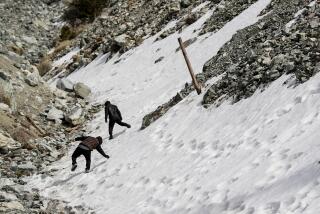Hiker’s body recovered from collapsed ice cave in Washington state
Washington state authorities needed explosives and the help of an avalanche technician Tuesday to retrieve the body of a hiker buried in a collapsed ice cave, authorities said.
Five other hikers were injured in Monday’s accident at the Big Four Ice Caves in the Mt. Baker-Snoqualmie National Forest, a popular hiking destination about 70 miles northeast of Seattle.
Dangerous conditions persisted, the Snohomish County Sheriff’s Office said in a statement.
“Areas of the cave are still collapsing and will continue to do so until the cave no longer exists. No one should go in or near the cave,” Search and Rescue Deputy Peter Teske said in the statement. “The area is not safe.”
An avalanche technician from the Washington State Department of Transportation assisted the operation to recover the body of a 34-year-old woman, the statement said. In addition, “search and rescue personnel used small explosives in the area of the caves to dislodge any possible debris, as well as check for stability of the ice.”
Three of the injured hikers were treated at hospitals and released. Two more remained hospitalized: a 25-year-old man in serious condition and a 35-year-old man in satisfactory condition, according to a spokeswoman for Harborview Medical Center in Seattle.
The ice cave collapse came Monday evening after a period of sustained warm weather.
Brenda Nelson, chief flight nurse for Airlift Northwest, which assisted in evacuating the injured, said the caves had been unstable for months.
“It’s been hot here, and all the ice is melting,” she said.
On Sunday, a portion of the caves collapsed in the heat but no one was injured, according to the Snohomish County Sheriff’s Office. Other sections of the cave had collapsed this year.
“As we head into the busiest and warmest part of the season, the cave is in its most dangerous state,” said Matthew Riggen, a lead field ranger from the U.S. Forest Service, in a statement from the Mt. Baker-Snoqualmie National Forest in May. “The cave is in a condition that we would normally not see until at least September – large, inviting and collapsing.”
At the time, visitors were urged to stay on the trail and to take extreme caution below Big Four Mountain, which is prone to falling rocks and ice.
Rangers counted at least 442 visitors to the Big Four hiking trail in early May, the Forest Service statement said.
The website of the Washington Trails Assn. warns hikers not to climb on top of the caves.
According to the Sheriff’s Office, there are dozens of warning signs at the trailhead, along the trail and sandblasted into boulders.
Kris Eyriason, a nurse in one of the first helicopters at the scene, said the lurking danger posed by the glacier was well-known among the community.
“It was just kind of a word-of-mouth thing. We had like, an unusually hot summer here; we were just kind of perplexed that someone would want to do that with the heat that’s been around here,” Eyriason said. “I hope those caves are closed off just so this doesn’t happen to someone else.”
The Sheriff’s Office said Tuesday that the area was closed to visitors until further notice.
One visitor at Big Four said she heard cracking sounds before Monday’s collapse.
Chloe Jakubowsi, 18, of Bothell, Calif., told the Seattle Times that she was just inside the cave when she heard the noise and saw ice and debris rain down.
“As soon as it stopped I looked up and looked around me and it was extremely gruesome, honestly,” she said. Jakubowski told the newspaper that it took at least a half-hour to drive to a payphone and tell rescuers about the collapse. There is no cell service in the area.
Over the last decade, there have been various accidents in or near the Big Four and other Washington ice caves.
In 2008, two teens were seriously injured in an ice cave collapse in Denny Creek, near Snoqualmie Pass, about 60 miles away from the Big Four Caves.
And in 2011, Grace Tam, an 11-year-old girl, was killed when a falling boulder rolled toward her. Her family sued the U.S. Forest Service, contending there were not enough warnings about the danger posed by ice avalanches. At the end of the trail, there is a warning sign in Grace’s memory.
Twitter: @natalieschachar
More to Read
Start your day right
Sign up for Essential California for news, features and recommendations from the L.A. Times and beyond in your inbox six days a week.
You may occasionally receive promotional content from the Los Angeles Times.






